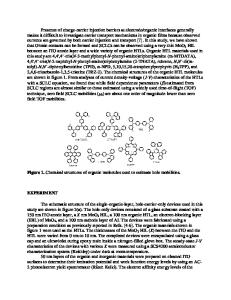Modeling of Mechanisms of Formation of Quasi-Epitaxial Organic Interfaces
- PDF / 437,095 Bytes
- 6 Pages / 414.72 x 648 pts Page_size
- 64 Downloads / 318 Views
CRITERIA FOR QUASI-EPITAXY The primary requirement for QE is that there exists a range over which a surface molecules can be translated relative to the substrate without significantly changing the system energy. If the potential between molecules within a layer is Pintra, and between molecules in different layers is Ointer, then this condition is related to the magnitudes of the inter- and intralayer compressibility (or elasticities) via: Ointra" )> Pinter", where 0" is the second derivative of 0 along the various crystalline directions and angles. That is, 0" is the elastic constant of the lattice along a particular direction. This condition for QE is independent of the relative magnitudes of the crystal binding energies, Ointra or Ointer. As in many cases involving large planar molecules, Ointer> dintra while Ointer"4 (intra". This differs from atomic vdW systems where there is no strict adherence to these conditions [1 1]. The crystalline compressibility has been examined by calculating the vdW bond energy between 2D interfaces of PTCDA and NTCDA using the atom-atom potential method [12]. Here, the total vdW potential is given by: D = X4ij, where 4ij is the potential between the i th andj th atoms in the two molecules which is found using
(1)
ij =-- ij + Pij exp(-yijrij) 'i)j
The radial distance between i andj in different molecules is rij, and a, f3.and y are vdW constants [13,14] for each pair of constituent atoms in molecules. The minimum energy corresponding to the equilibrium crystal configuration is obtained when (' = 0 and (I" > 0. As a test of the accuracy of the method, we have calculated the minimum energy configuration of both the bulk and surface PTCDA unit cells, and compared the results with the observed crystal structures [3-5]. These results are provided in Table I, with the crystalline dimensional parameters defined in the Fig. 1, showing calculation and observation are in good agreement. Once tested the accuracy of the model on known, we next test the validity of the QE condition. We generated the energy surface for PTCDA and NTCDA dimer shown in Fig. 2 by fixing the stacking distance along the c unit cell axis and translating the two molecules with respect to each other in the x, y (base) plane. The energy minimum is broad, implying that the NTCDA molecule can be displaced relative to the PTCDA substrate over more that 1 A without significantly changing the total energy. It indicates that there exists a broad region of energy equivalent positions between PTCDA and NTCDA molecules, which therefore results in the growth of an incommensurate overlayer with only a small interfacial stress, as required for ordered QE growth. Next we calculated intermolecular elasticity of the NTCDA-NTCDA bond TABLE I. Calculated and measured unit cell parameters ror PTCDA. Surface unit cell parameters'
Theory
STM RHEED
a 9
a
b
a
(A)
(A)
(rad)
(rad)
(rad)
Ref.
20.0 = 0.5 21.6"t2 22.4 = 1.0
15.7 ± 0.5
0.86 ± 0.02
0.48 = 0.02
0.86 ± 0.02
This work
15.221.6 16.0"t 1.0
0.96=0.03
0.61 ±0.17
0.S:=
Data Loading...











